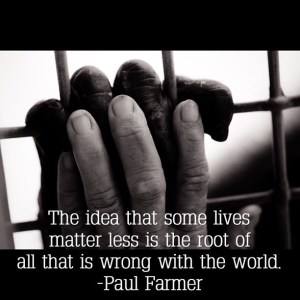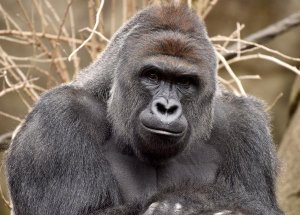 The internet is filled with emotional posts over the fatal shooting of a critically endangered Western Lowland Gorilla named Harambe at the Cincinnati Zoo yesterday after a four year old child climbed into his enclosure. The previous day had been Harambe’s 17th birthday.
The internet is filled with emotional posts over the fatal shooting of a critically endangered Western Lowland Gorilla named Harambe at the Cincinnati Zoo yesterday after a four year old child climbed into his enclosure. The previous day had been Harambe’s 17th birthday.
There are heartbreaking stories about the things we humans do to our fellow animals circulating the internet at a near constant rate. It’s not every story that breaks through in the way Harambe’s has. Perhaps the difference here is that Harambe’s death and the discussions that accompany it distill so clearly all that we humans get wrong in our treatment of species who aren’t us. And if we follow the ripples out far enough, our treatment of one another as well.
Let’s look at how Harambe came to find himself in that enclosure to begin with. Zoos in most Western countries these days at least have the sense of guilt to position themselves as noble conservationists. But is conservation in captivity the best we can do? And is this position an honest one? Zoos certainly were not founded for the purpose of conservation. Like their cousins, circuses, marine parks, and aquariums, they were initially created for human entertainment.
It is only with the evolution of human opinion and the advancement of science in support of animal rights that these types of exploitative entities have shifted their focus and professed mission. That is not to vilify the many staff members who go into work at such places out of a genuine love of animals. But it most certainly is to question the continued existence of these places and examine what a better path forward may look like.
First, the idea that we need zoos in order to have conservation programs is false. Very few animals bred in captivity can ever be released into the wild which means we are breeding animals almost exclusively to live life in captivity. Furthermore, an important argument can be made that such conservation programs draw our focus and resources from potentially more impactful and effective conservation programs in the wild. Rather than ‘rescuing’ endangered species from the degradation to their natural habitats, hunting, poaching, and disease – the vast majority of which are caused by us humans – by bringing them into captivity, we could be creating more programs that protect those habitats, wildlife refuges that treat and release injured and orphaned animals back into the wild whenever possible, and realistically facing the threat our degradation of the environment as a whole has on this planet and all of us who live here.
What about the so-called education component and the idea that zoos and circuses teach children to care about animals? This one is perhaps the most abhorrent argument made in favor of such entities. What we are teaching are exactly the wrong lessons. Children are born with an innate love of and curiosity about animals and one need only look at their fascination and depth of knowledge about dinosaurs to know it does not take a creature in a cage to foster passionate engagement. What zoos, circuses and the like do is normalize captivity, exploitation, subjugation, and the notion of superiority. If in doubt, simply look at the way many spectators engage with the animals during their visits to the zoo. There are myriad opportunities for children (and adults) to learn about and engage with animals in ways that foster empathy, compassion, and stewardship away from the unnatural spectacle of gawking at animals held in captivity.
Finally, what about the effects of captivity on the animals themselves? The more we study them, the more we understand, the clearer it becomes that life in captivity is inhumane, unethical, and overwhelmingly detrimental to wild animals. From marine mammals, to chimpanzees, to elephants, animals living in captivity show rampant and significant signs of mental illness and suffer shortened life spans.
-Read More: 5 Things We Need to Stop Telling Ourselves About Zoos-
Harambe’s death occurs during a sea change in popular opinion. While as a species, humans are not nearly as far along as our fellow animals need us to be in understanding and taking the steps needed to end their exploitation at our hands, we are moving in that direction. We are starting to more fully acknowledge the sentience of other species. We have begun to see the misery and injustice inherent in animals held captive for our entertainment.
Harambe was bred in captivity. In our human dominated world, he never had a chance to fight for his own species’ survival or to have a voice in the trajectory of his own life. When a child fell into the enclosure in which he lived not by choice, but by the will of humans, he paid for the choices and mistakes of humans with his life. It was again, a decision in which he had no choice and no power. He was the dangerous wild animal and of course, in the view of humans, the human child’s safety came first and the gorilla was killed for a ‘crime’ no one is quite sure he would have committed.
In a just world, Harambe never would have been in that enclosure to begin with. The enclosure would not have existed. Wild animals would live in the wild and humans would look at first doing no harm to their species and the habitats in which they live so that perhaps we would not then need to ‘save’ them from ourselves.
As this is not a just world, we must look at the path forward. Saving endangered and threatened wild animals is inextricably tied to saving our own planet and in turn, saving ourselves. If we are being honest when we say that we support zoos not for entertainment, but for conservation efforts, we must acknowledge that captive breeding programs as they exist are a bandaid and a not fully sustainable shortcut. Harambe’s death is a painful reminder that turning a blind eye to the greater problems we face and allowing ourselves to be appeased by surface level efforts has created a system of gross injustice that is eventually going to catch up to us all.
Even a brief look at the concept of ecology reminds us that we are all connected, that the earth is one great big interdependent ecosystem. The species who don’t speak our language suffer the worst of our exploitative culture, followed by the poor amongst ourselves who lack the resources to make their voices heard. But make no mistake, the consequences of both our actions and inactions will travel up the hierarchy. The injustice of Harambe’s death is a stark reminder of our global society’s power dynamics. Permeating the comments online are a wide range of emotions; true heartbreak on his behalf, anger and outrage at the circumstances that led to his fate, and on the other side, anger and defensiveness that it’s not our fault, that humans are superior, that he was ‘just an animal.’
 There is an incredible danger inherent in that latter viewpoint. It is the arrogant, entitled, ignorant callousness that led to Harambe’s death. On a larger scale, it is leading the human race to tear ourselves apart, separating into factions, creating otherness where it does not truly exist, justifying actions that pollute, destroy, and in very real terms, cost the lives of those around us. Humans share 98% of our DNA with gorillas. The notion that they are ‘just animals’ and we are something else entirely, unrelated to the creatures we keep in cages, is absurd. But when we are able to undervalue the lives of members of our own species based on skin color or geography or religion or gender or economic status, it is unsurprising some of us have trouble seeing the value and the complex life present in other species, present in a gorilla named Harambe.
There is an incredible danger inherent in that latter viewpoint. It is the arrogant, entitled, ignorant callousness that led to Harambe’s death. On a larger scale, it is leading the human race to tear ourselves apart, separating into factions, creating otherness where it does not truly exist, justifying actions that pollute, destroy, and in very real terms, cost the lives of those around us. Humans share 98% of our DNA with gorillas. The notion that they are ‘just animals’ and we are something else entirely, unrelated to the creatures we keep in cages, is absurd. But when we are able to undervalue the lives of members of our own species based on skin color or geography or religion or gender or economic status, it is unsurprising some of us have trouble seeing the value and the complex life present in other species, present in a gorilla named Harambe.